Report about Climate Change 2022
VerifiedAdded on 2022/10/01
|13
|2760
|19
AI Summary
Contribute Materials
Your contribution can guide someone’s learning journey. Share your
documents today.
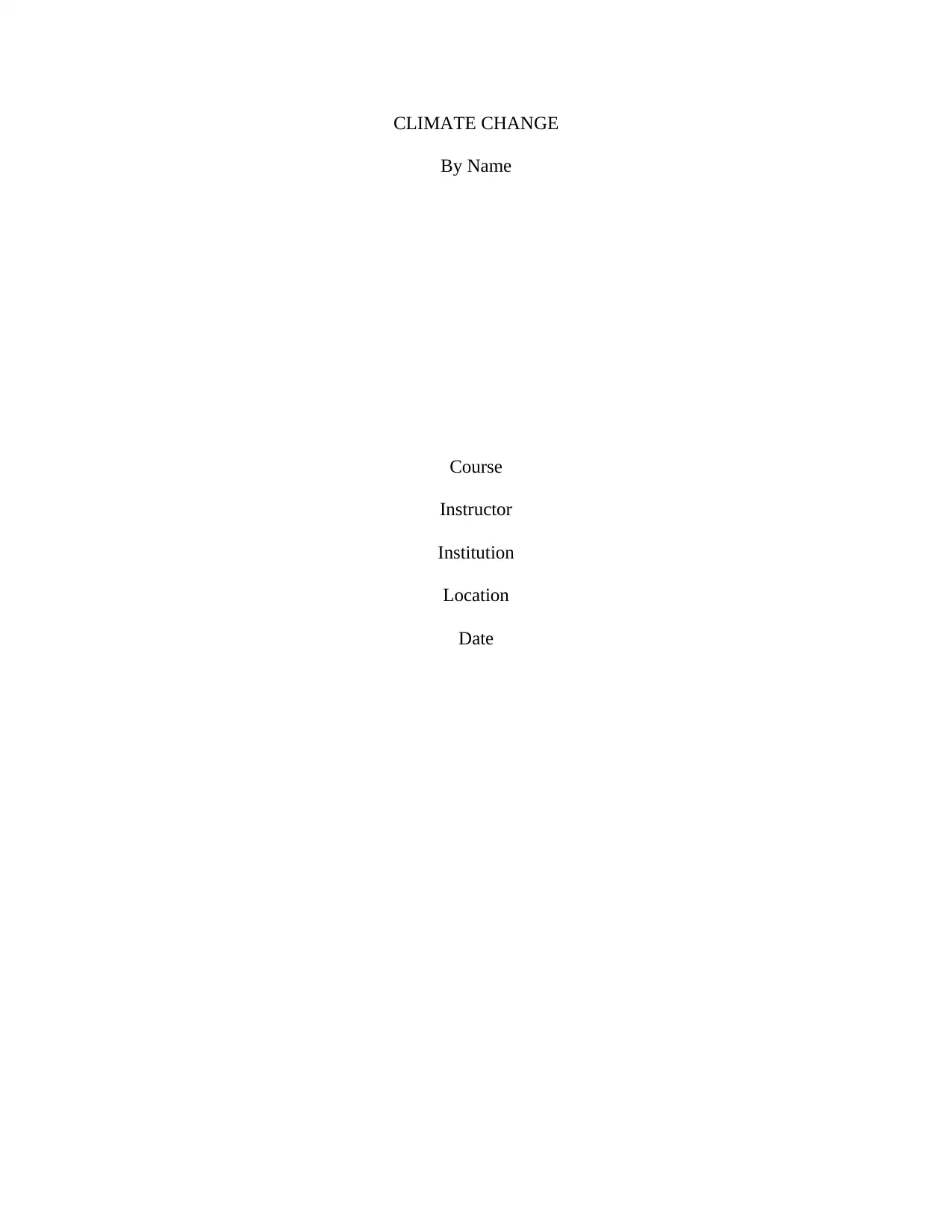
CLIMATE CHANGE
By Name
Course
Instructor
Institution
Location
Date
By Name
Course
Instructor
Institution
Location
Date
Secure Best Marks with AI Grader
Need help grading? Try our AI Grader for instant feedback on your assignments.

Introduction
The world is getting water by about 1.5⁰C and this heating if continued would have devastating
impacts on the current as well as future generations. The authoritative report that has been
released by the Intergovernmental Panel on Climate Change give the world a rather clear target:
emission of greenhouse gases has to be reduced to net-zero by mid of 21st century if the
aspirations to have a reasonable opportunity of reducing global warming to 1.5⁰C are anything to
go by (Deutsch et al., 2018). Climate change has turned out to be one of the most challenging
and complex issues that are facing humans in the world today. It encompasses numerous
dimensions including but not limited to society, science, politics, economics as well as moral and
ethical concerns and is a global concern whose effect is being felt both on local and international
scales that will stay with us for decades and centuries to come.
The heat-trapping gas is carbon dioxide has been the main cause of the current global warming
and remains to be suspended in the atmosphere for numerous years with the planet, more
specifically the oceans, taking some time to respond to global warming. This means even if the
emission of all the possible greenhouse gases was stopped today, the effect of global warming
and climate change will still be felt by the generations to come. In such a manner, humanity
tends to be attached to climate change to some extent. Enhancing the transition to clean as well
as sustainable growth is the responsibility of any government lest its citizens suffer the mounting
destruction from rises in sea levels, droughts alongside flooding which will severe implications
on the efforts made towards tackling raised living standards, poverty and enhance prosperity.
The world is getting water by about 1.5⁰C and this heating if continued would have devastating
impacts on the current as well as future generations. The authoritative report that has been
released by the Intergovernmental Panel on Climate Change give the world a rather clear target:
emission of greenhouse gases has to be reduced to net-zero by mid of 21st century if the
aspirations to have a reasonable opportunity of reducing global warming to 1.5⁰C are anything to
go by (Deutsch et al., 2018). Climate change has turned out to be one of the most challenging
and complex issues that are facing humans in the world today. It encompasses numerous
dimensions including but not limited to society, science, politics, economics as well as moral and
ethical concerns and is a global concern whose effect is being felt both on local and international
scales that will stay with us for decades and centuries to come.
The heat-trapping gas is carbon dioxide has been the main cause of the current global warming
and remains to be suspended in the atmosphere for numerous years with the planet, more
specifically the oceans, taking some time to respond to global warming. This means even if the
emission of all the possible greenhouse gases was stopped today, the effect of global warming
and climate change will still be felt by the generations to come. In such a manner, humanity
tends to be attached to climate change to some extent. Enhancing the transition to clean as well
as sustainable growth is the responsibility of any government lest its citizens suffer the mounting
destruction from rises in sea levels, droughts alongside flooding which will severe implications
on the efforts made towards tackling raised living standards, poverty and enhance prosperity.
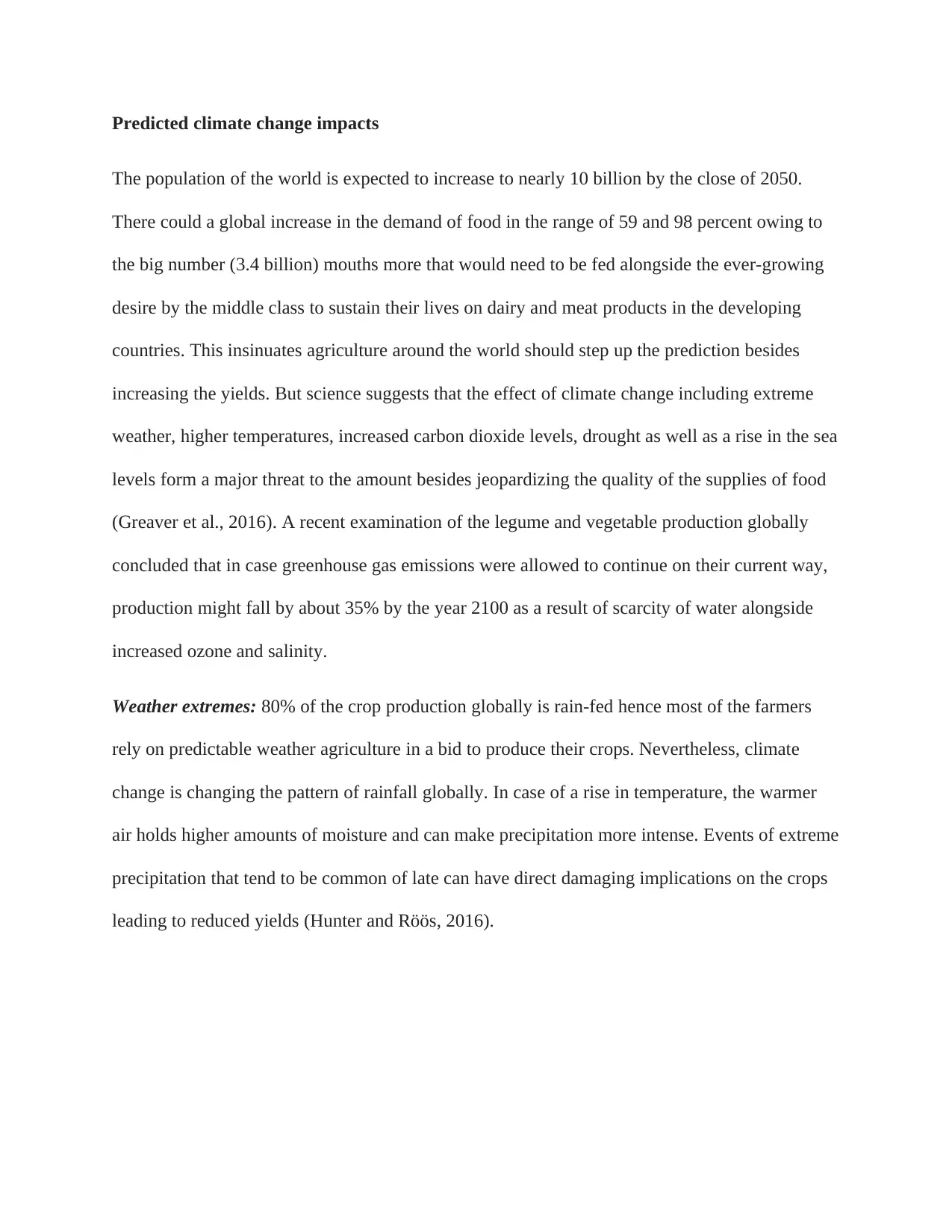
Predicted climate change impacts
The population of the world is expected to increase to nearly 10 billion by the close of 2050.
There could a global increase in the demand of food in the range of 59 and 98 percent owing to
the big number (3.4 billion) mouths more that would need to be fed alongside the ever-growing
desire by the middle class to sustain their lives on dairy and meat products in the developing
countries. This insinuates agriculture around the world should step up the prediction besides
increasing the yields. But science suggests that the effect of climate change including extreme
weather, higher temperatures, increased carbon dioxide levels, drought as well as a rise in the sea
levels form a major threat to the amount besides jeopardizing the quality of the supplies of food
(Greaver et al., 2016). A recent examination of the legume and vegetable production globally
concluded that in case greenhouse gas emissions were allowed to continue on their current way,
production might fall by about 35% by the year 2100 as a result of scarcity of water alongside
increased ozone and salinity.
Weather extremes: 80% of the crop production globally is rain-fed hence most of the farmers
rely on predictable weather agriculture in a bid to produce their crops. Nevertheless, climate
change is changing the pattern of rainfall globally. In case of a rise in temperature, the warmer
air holds higher amounts of moisture and can make precipitation more intense. Events of extreme
precipitation that tend to be common of late can have direct damaging implications on the crops
leading to reduced yields (Hunter and Röös, 2016).
The population of the world is expected to increase to nearly 10 billion by the close of 2050.
There could a global increase in the demand of food in the range of 59 and 98 percent owing to
the big number (3.4 billion) mouths more that would need to be fed alongside the ever-growing
desire by the middle class to sustain their lives on dairy and meat products in the developing
countries. This insinuates agriculture around the world should step up the prediction besides
increasing the yields. But science suggests that the effect of climate change including extreme
weather, higher temperatures, increased carbon dioxide levels, drought as well as a rise in the sea
levels form a major threat to the amount besides jeopardizing the quality of the supplies of food
(Greaver et al., 2016). A recent examination of the legume and vegetable production globally
concluded that in case greenhouse gas emissions were allowed to continue on their current way,
production might fall by about 35% by the year 2100 as a result of scarcity of water alongside
increased ozone and salinity.
Weather extremes: 80% of the crop production globally is rain-fed hence most of the farmers
rely on predictable weather agriculture in a bid to produce their crops. Nevertheless, climate
change is changing the pattern of rainfall globally. In case of a rise in temperature, the warmer
air holds higher amounts of moisture and can make precipitation more intense. Events of extreme
precipitation that tend to be common of late can have direct damaging implications on the crops
leading to reduced yields (Hunter and Röös, 2016).
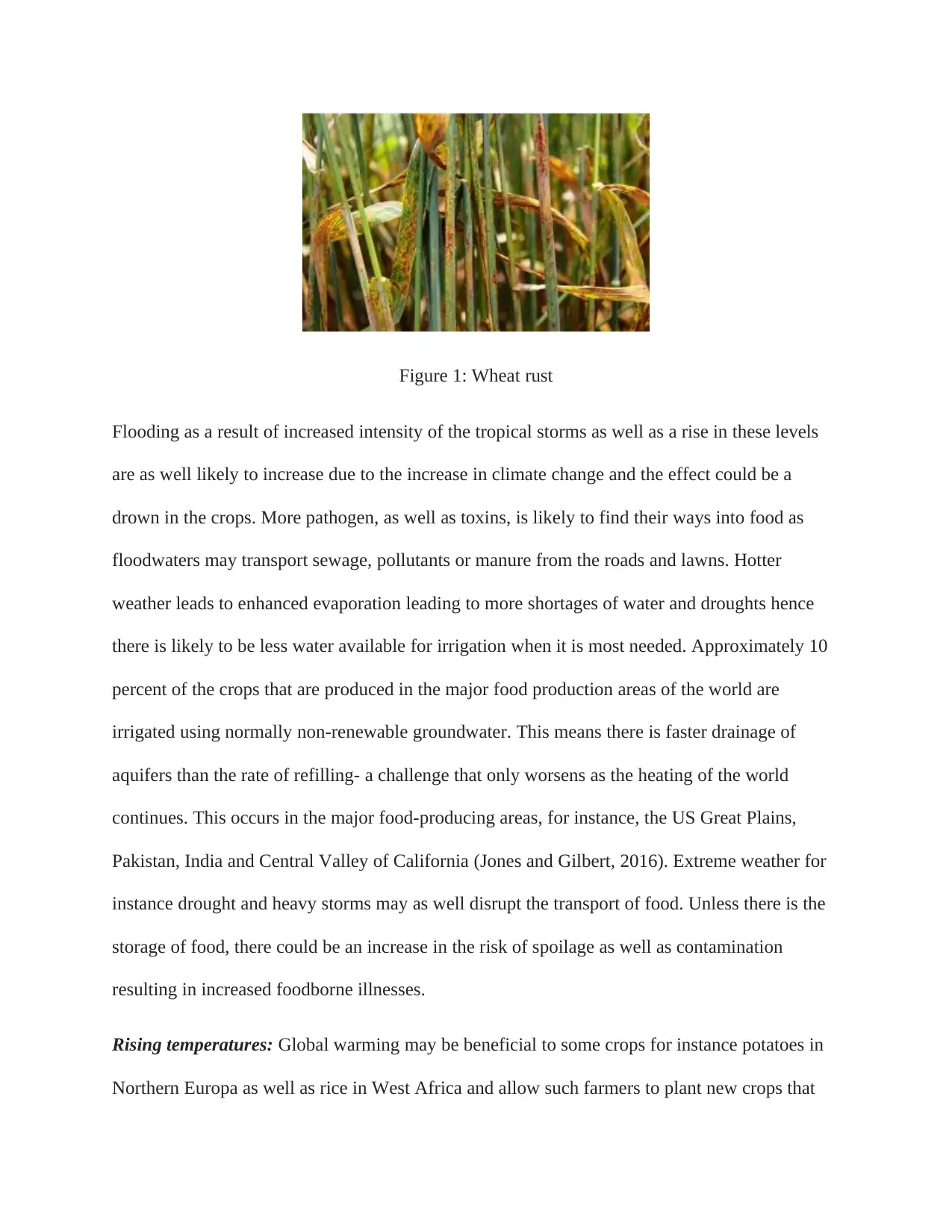
Figure 1: Wheat rust
Flooding as a result of increased intensity of the tropical storms as well as a rise in these levels
are as well likely to increase due to the increase in climate change and the effect could be a
drown in the crops. More pathogen, as well as toxins, is likely to find their ways into food as
floodwaters may transport sewage, pollutants or manure from the roads and lawns. Hotter
weather leads to enhanced evaporation leading to more shortages of water and droughts hence
there is likely to be less water available for irrigation when it is most needed. Approximately 10
percent of the crops that are produced in the major food production areas of the world are
irrigated using normally non-renewable groundwater. This means there is faster drainage of
aquifers than the rate of refilling- a challenge that only worsens as the heating of the world
continues. This occurs in the major food-producing areas, for instance, the US Great Plains,
Pakistan, India and Central Valley of California (Jones and Gilbert, 2016). Extreme weather for
instance drought and heavy storms may as well disrupt the transport of food. Unless there is the
storage of food, there could be an increase in the risk of spoilage as well as contamination
resulting in increased foodborne illnesses.
Rising temperatures: Global warming may be beneficial to some crops for instance potatoes in
Northern Europa as well as rice in West Africa and allow such farmers to plant new crops that
Flooding as a result of increased intensity of the tropical storms as well as a rise in these levels
are as well likely to increase due to the increase in climate change and the effect could be a
drown in the crops. More pathogen, as well as toxins, is likely to find their ways into food as
floodwaters may transport sewage, pollutants or manure from the roads and lawns. Hotter
weather leads to enhanced evaporation leading to more shortages of water and droughts hence
there is likely to be less water available for irrigation when it is most needed. Approximately 10
percent of the crops that are produced in the major food production areas of the world are
irrigated using normally non-renewable groundwater. This means there is faster drainage of
aquifers than the rate of refilling- a challenge that only worsens as the heating of the world
continues. This occurs in the major food-producing areas, for instance, the US Great Plains,
Pakistan, India and Central Valley of California (Jones and Gilbert, 2016). Extreme weather for
instance drought and heavy storms may as well disrupt the transport of food. Unless there is the
storage of food, there could be an increase in the risk of spoilage as well as contamination
resulting in increased foodborne illnesses.
Rising temperatures: Global warming may be beneficial to some crops for instance potatoes in
Northern Europa as well as rice in West Africa and allow such farmers to plant new crops that
Secure Best Marks with AI Grader
Need help grading? Try our AI Grader for instant feedback on your assignments.
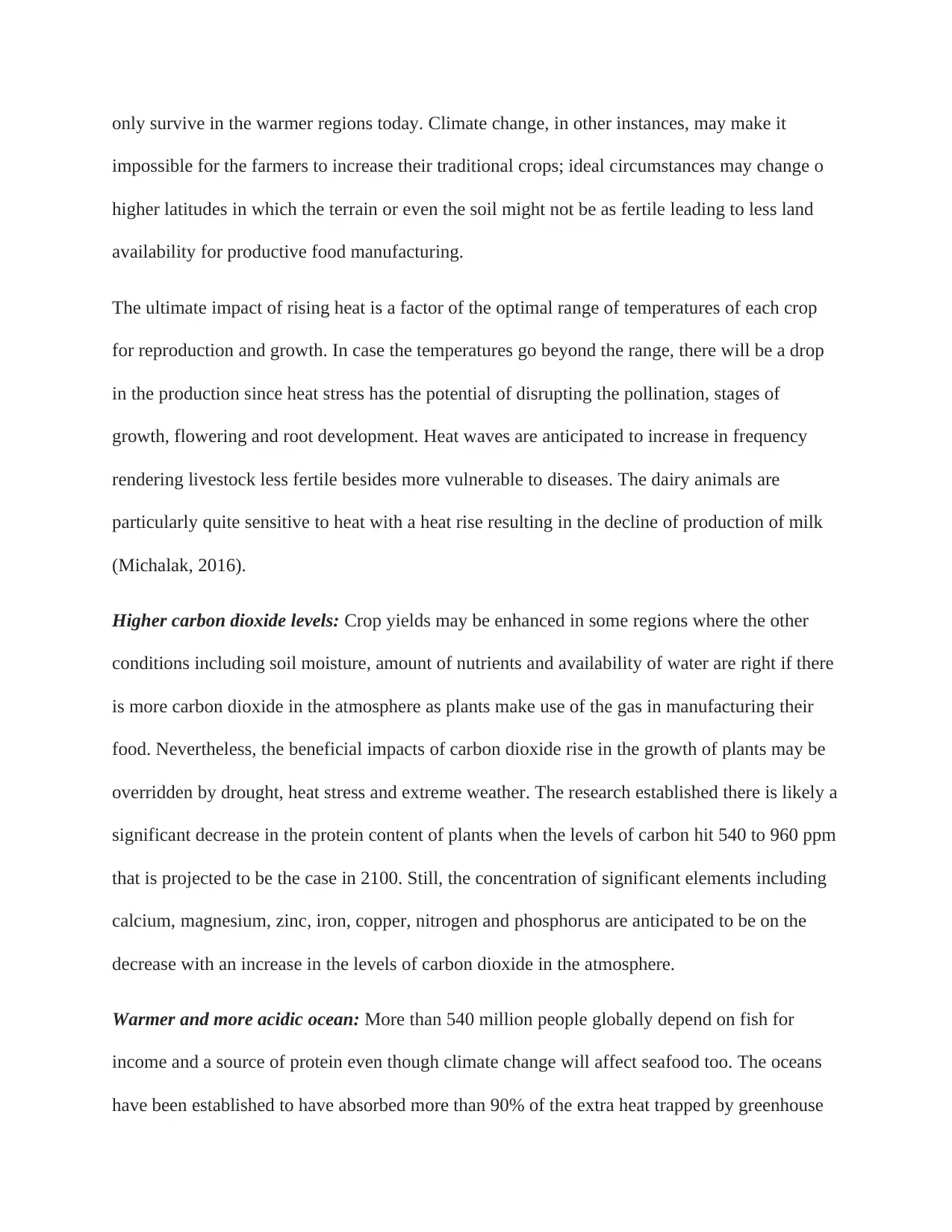
only survive in the warmer regions today. Climate change, in other instances, may make it
impossible for the farmers to increase their traditional crops; ideal circumstances may change o
higher latitudes in which the terrain or even the soil might not be as fertile leading to less land
availability for productive food manufacturing.
The ultimate impact of rising heat is a factor of the optimal range of temperatures of each crop
for reproduction and growth. In case the temperatures go beyond the range, there will be a drop
in the production since heat stress has the potential of disrupting the pollination, stages of
growth, flowering and root development. Heat waves are anticipated to increase in frequency
rendering livestock less fertile besides more vulnerable to diseases. The dairy animals are
particularly quite sensitive to heat with a heat rise resulting in the decline of production of milk
(Michalak, 2016).
Higher carbon dioxide levels: Crop yields may be enhanced in some regions where the other
conditions including soil moisture, amount of nutrients and availability of water are right if there
is more carbon dioxide in the atmosphere as plants make use of the gas in manufacturing their
food. Nevertheless, the beneficial impacts of carbon dioxide rise in the growth of plants may be
overridden by drought, heat stress and extreme weather. The research established there is likely a
significant decrease in the protein content of plants when the levels of carbon hit 540 to 960 ppm
that is projected to be the case in 2100. Still, the concentration of significant elements including
calcium, magnesium, zinc, iron, copper, nitrogen and phosphorus are anticipated to be on the
decrease with an increase in the levels of carbon dioxide in the atmosphere.
Warmer and more acidic ocean: More than 540 million people globally depend on fish for
income and a source of protein even though climate change will affect seafood too. The oceans
have been established to have absorbed more than 90% of the extra heat trapped by greenhouse
impossible for the farmers to increase their traditional crops; ideal circumstances may change o
higher latitudes in which the terrain or even the soil might not be as fertile leading to less land
availability for productive food manufacturing.
The ultimate impact of rising heat is a factor of the optimal range of temperatures of each crop
for reproduction and growth. In case the temperatures go beyond the range, there will be a drop
in the production since heat stress has the potential of disrupting the pollination, stages of
growth, flowering and root development. Heat waves are anticipated to increase in frequency
rendering livestock less fertile besides more vulnerable to diseases. The dairy animals are
particularly quite sensitive to heat with a heat rise resulting in the decline of production of milk
(Michalak, 2016).
Higher carbon dioxide levels: Crop yields may be enhanced in some regions where the other
conditions including soil moisture, amount of nutrients and availability of water are right if there
is more carbon dioxide in the atmosphere as plants make use of the gas in manufacturing their
food. Nevertheless, the beneficial impacts of carbon dioxide rise in the growth of plants may be
overridden by drought, heat stress and extreme weather. The research established there is likely a
significant decrease in the protein content of plants when the levels of carbon hit 540 to 960 ppm
that is projected to be the case in 2100. Still, the concentration of significant elements including
calcium, magnesium, zinc, iron, copper, nitrogen and phosphorus are anticipated to be on the
decrease with an increase in the levels of carbon dioxide in the atmosphere.
Warmer and more acidic ocean: More than 540 million people globally depend on fish for
income and a source of protein even though climate change will affect seafood too. The oceans
have been established to have absorbed more than 90% of the extra heat trapped by greenhouse
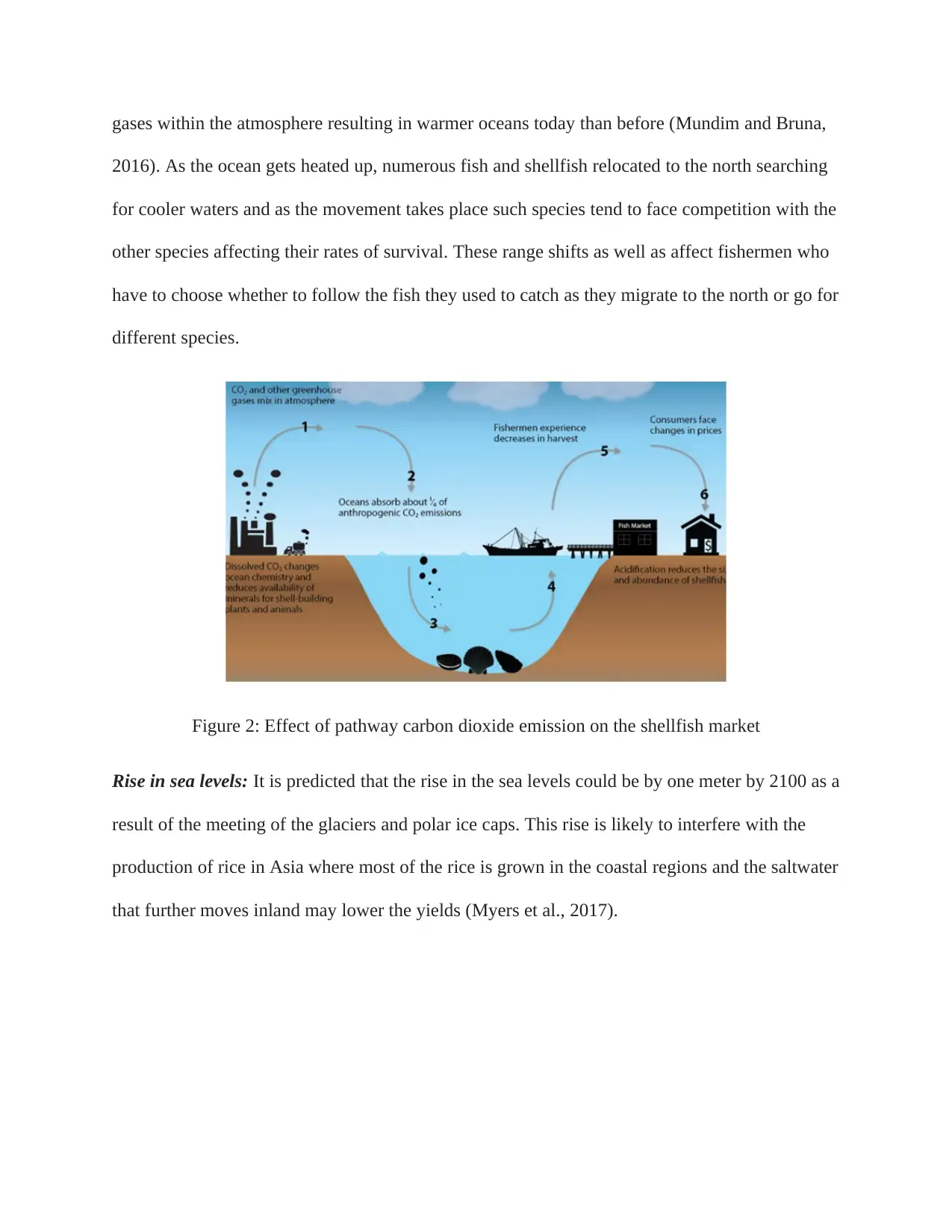
gases within the atmosphere resulting in warmer oceans today than before (Mundim and Bruna,
2016). As the ocean gets heated up, numerous fish and shellfish relocated to the north searching
for cooler waters and as the movement takes place such species tend to face competition with the
other species affecting their rates of survival. These range shifts as well as affect fishermen who
have to choose whether to follow the fish they used to catch as they migrate to the north or go for
different species.
Figure 2: Effect of pathway carbon dioxide emission on the shellfish market
Rise in sea levels: It is predicted that the rise in the sea levels could be by one meter by 2100 as a
result of the meeting of the glaciers and polar ice caps. This rise is likely to interfere with the
production of rice in Asia where most of the rice is grown in the coastal regions and the saltwater
that further moves inland may lower the yields (Myers et al., 2017).
2016). As the ocean gets heated up, numerous fish and shellfish relocated to the north searching
for cooler waters and as the movement takes place such species tend to face competition with the
other species affecting their rates of survival. These range shifts as well as affect fishermen who
have to choose whether to follow the fish they used to catch as they migrate to the north or go for
different species.
Figure 2: Effect of pathway carbon dioxide emission on the shellfish market
Rise in sea levels: It is predicted that the rise in the sea levels could be by one meter by 2100 as a
result of the meeting of the glaciers and polar ice caps. This rise is likely to interfere with the
production of rice in Asia where most of the rice is grown in the coastal regions and the saltwater
that further moves inland may lower the yields (Myers et al., 2017).
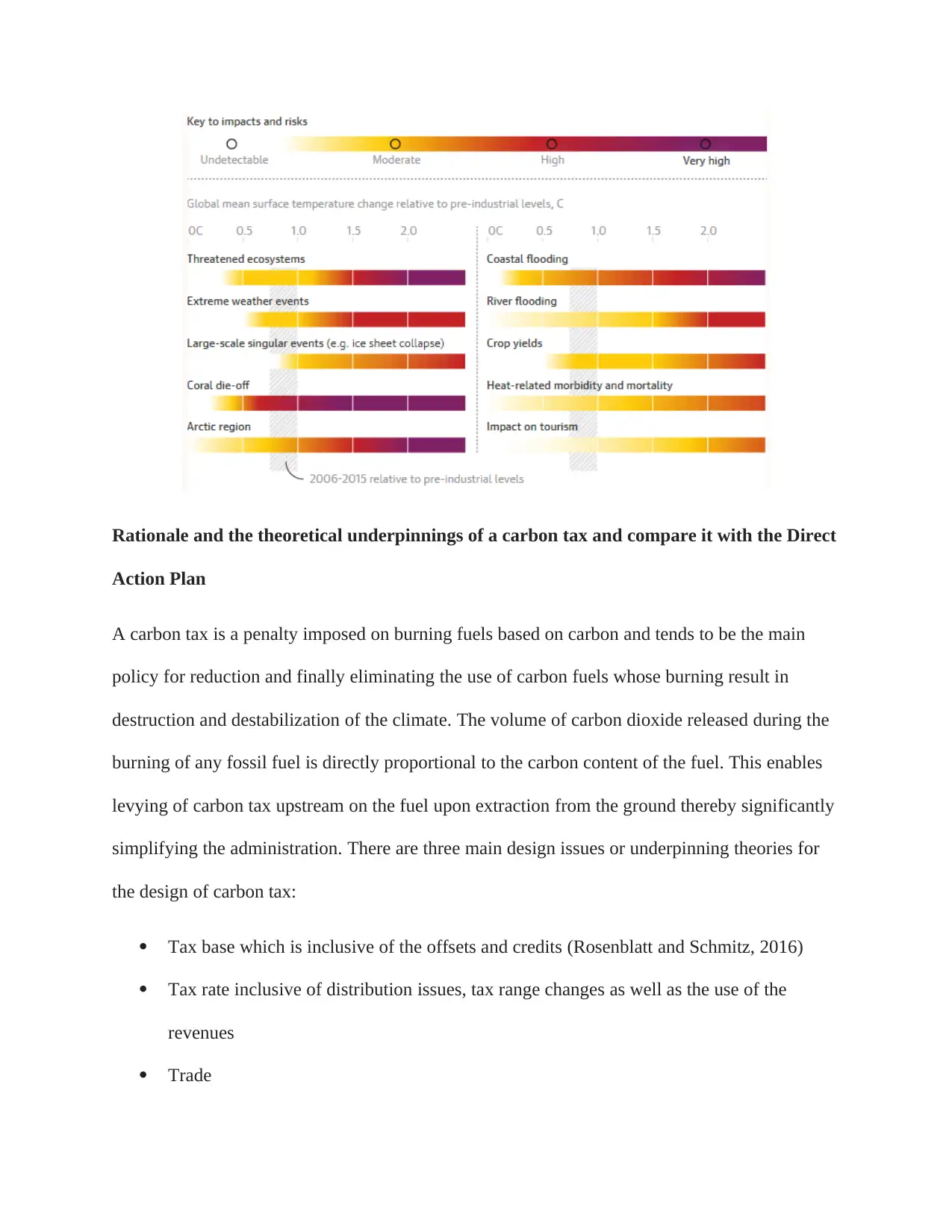
Rationale and the theoretical underpinnings of a carbon tax and compare it with the Direct
Action Plan
A carbon tax is a penalty imposed on burning fuels based on carbon and tends to be the main
policy for reduction and finally eliminating the use of carbon fuels whose burning result in
destruction and destabilization of the climate. The volume of carbon dioxide released during the
burning of any fossil fuel is directly proportional to the carbon content of the fuel. This enables
levying of carbon tax upstream on the fuel upon extraction from the ground thereby significantly
simplifying the administration. There are three main design issues or underpinning theories for
the design of carbon tax:
Tax base which is inclusive of the offsets and credits (Rosenblatt and Schmitz, 2016)
Tax rate inclusive of distribution issues, tax range changes as well as the use of the
revenues
Trade
Action Plan
A carbon tax is a penalty imposed on burning fuels based on carbon and tends to be the main
policy for reduction and finally eliminating the use of carbon fuels whose burning result in
destruction and destabilization of the climate. The volume of carbon dioxide released during the
burning of any fossil fuel is directly proportional to the carbon content of the fuel. This enables
levying of carbon tax upstream on the fuel upon extraction from the ground thereby significantly
simplifying the administration. There are three main design issues or underpinning theories for
the design of carbon tax:
Tax base which is inclusive of the offsets and credits (Rosenblatt and Schmitz, 2016)
Tax rate inclusive of distribution issues, tax range changes as well as the use of the
revenues
Trade
Paraphrase This Document
Need a fresh take? Get an instant paraphrase of this document with our AI Paraphraser
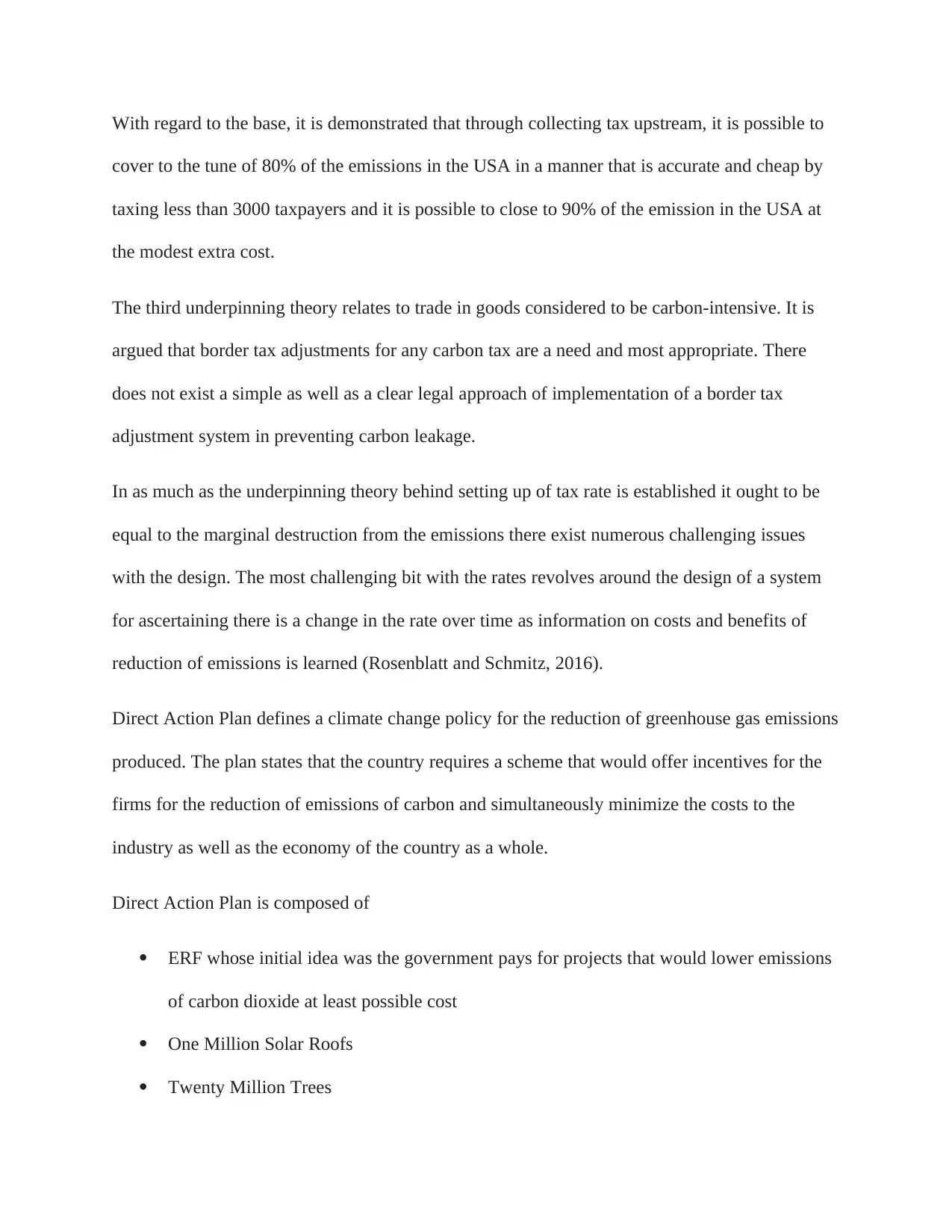
With regard to the base, it is demonstrated that through collecting tax upstream, it is possible to
cover to the tune of 80% of the emissions in the USA in a manner that is accurate and cheap by
taxing less than 3000 taxpayers and it is possible to close to 90% of the emission in the USA at
the modest extra cost.
The third underpinning theory relates to trade in goods considered to be carbon-intensive. It is
argued that border tax adjustments for any carbon tax are a need and most appropriate. There
does not exist a simple as well as a clear legal approach of implementation of a border tax
adjustment system in preventing carbon leakage.
In as much as the underpinning theory behind setting up of tax rate is established it ought to be
equal to the marginal destruction from the emissions there exist numerous challenging issues
with the design. The most challenging bit with the rates revolves around the design of a system
for ascertaining there is a change in the rate over time as information on costs and benefits of
reduction of emissions is learned (Rosenblatt and Schmitz, 2016).
Direct Action Plan defines a climate change policy for the reduction of greenhouse gas emissions
produced. The plan states that the country requires a scheme that would offer incentives for the
firms for the reduction of emissions of carbon and simultaneously minimize the costs to the
industry as well as the economy of the country as a whole.
Direct Action Plan is composed of
ERF whose initial idea was the government pays for projects that would lower emissions
of carbon dioxide at least possible cost
One Million Solar Roofs
Twenty Million Trees
cover to the tune of 80% of the emissions in the USA in a manner that is accurate and cheap by
taxing less than 3000 taxpayers and it is possible to close to 90% of the emission in the USA at
the modest extra cost.
The third underpinning theory relates to trade in goods considered to be carbon-intensive. It is
argued that border tax adjustments for any carbon tax are a need and most appropriate. There
does not exist a simple as well as a clear legal approach of implementation of a border tax
adjustment system in preventing carbon leakage.
In as much as the underpinning theory behind setting up of tax rate is established it ought to be
equal to the marginal destruction from the emissions there exist numerous challenging issues
with the design. The most challenging bit with the rates revolves around the design of a system
for ascertaining there is a change in the rate over time as information on costs and benefits of
reduction of emissions is learned (Rosenblatt and Schmitz, 2016).
Direct Action Plan defines a climate change policy for the reduction of greenhouse gas emissions
produced. The plan states that the country requires a scheme that would offer incentives for the
firms for the reduction of emissions of carbon and simultaneously minimize the costs to the
industry as well as the economy of the country as a whole.
Direct Action Plan is composed of
ERF whose initial idea was the government pays for projects that would lower emissions
of carbon dioxide at least possible cost
One Million Solar Roofs
Twenty Million Trees
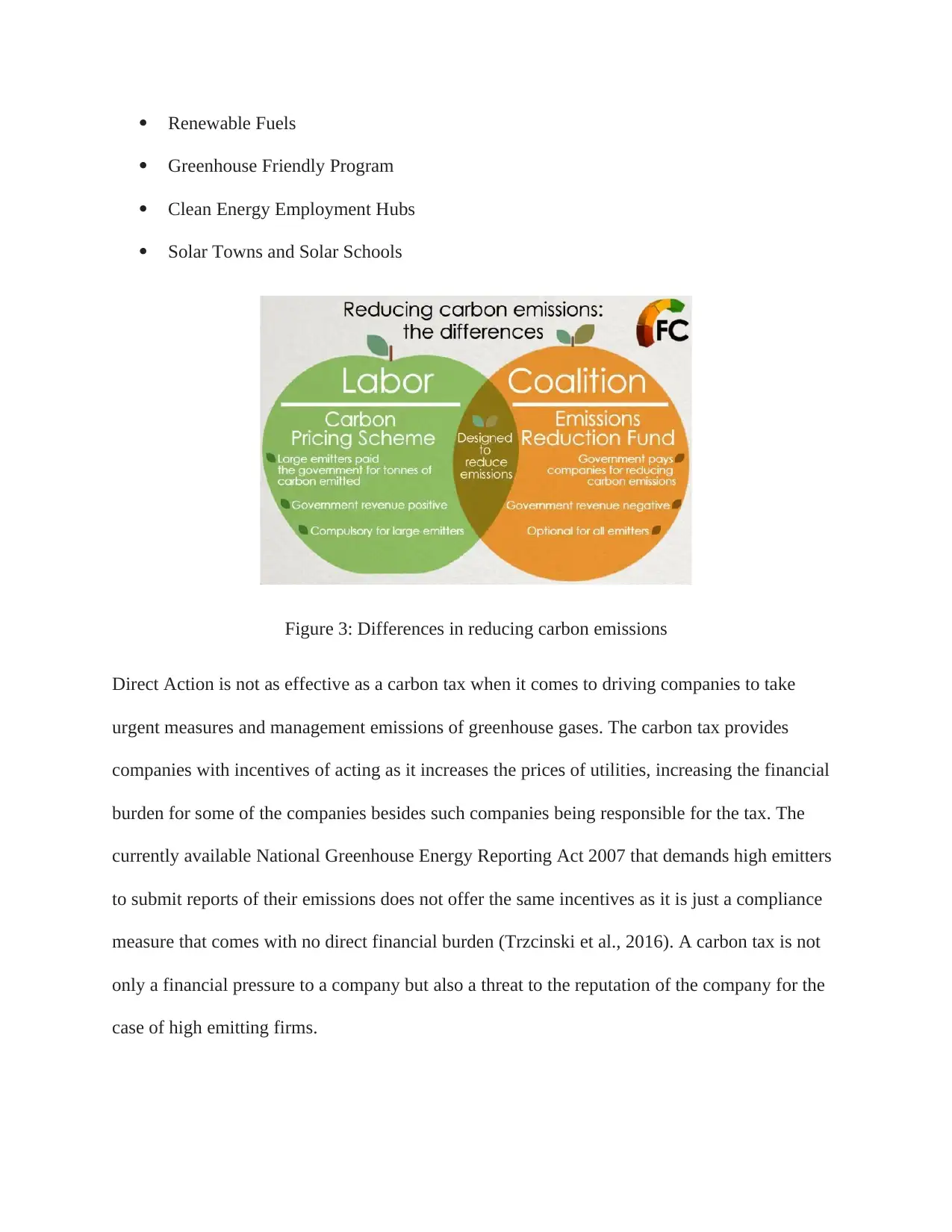
Renewable Fuels
Greenhouse Friendly Program
Clean Energy Employment Hubs
Solar Towns and Solar Schools
Figure 3: Differences in reducing carbon emissions
Direct Action is not as effective as a carbon tax when it comes to driving companies to take
urgent measures and management emissions of greenhouse gases. The carbon tax provides
companies with incentives of acting as it increases the prices of utilities, increasing the financial
burden for some of the companies besides such companies being responsible for the tax. The
currently available National Greenhouse Energy Reporting Act 2007 that demands high emitters
to submit reports of their emissions does not offer the same incentives as it is just a compliance
measure that comes with no direct financial burden (Trzcinski et al., 2016). A carbon tax is not
only a financial pressure to a company but also a threat to the reputation of the company for the
case of high emitting firms.
Greenhouse Friendly Program
Clean Energy Employment Hubs
Solar Towns and Solar Schools
Figure 3: Differences in reducing carbon emissions
Direct Action is not as effective as a carbon tax when it comes to driving companies to take
urgent measures and management emissions of greenhouse gases. The carbon tax provides
companies with incentives of acting as it increases the prices of utilities, increasing the financial
burden for some of the companies besides such companies being responsible for the tax. The
currently available National Greenhouse Energy Reporting Act 2007 that demands high emitters
to submit reports of their emissions does not offer the same incentives as it is just a compliance
measure that comes with no direct financial burden (Trzcinski et al., 2016). A carbon tax is not
only a financial pressure to a company but also a threat to the reputation of the company for the
case of high emitting firms.
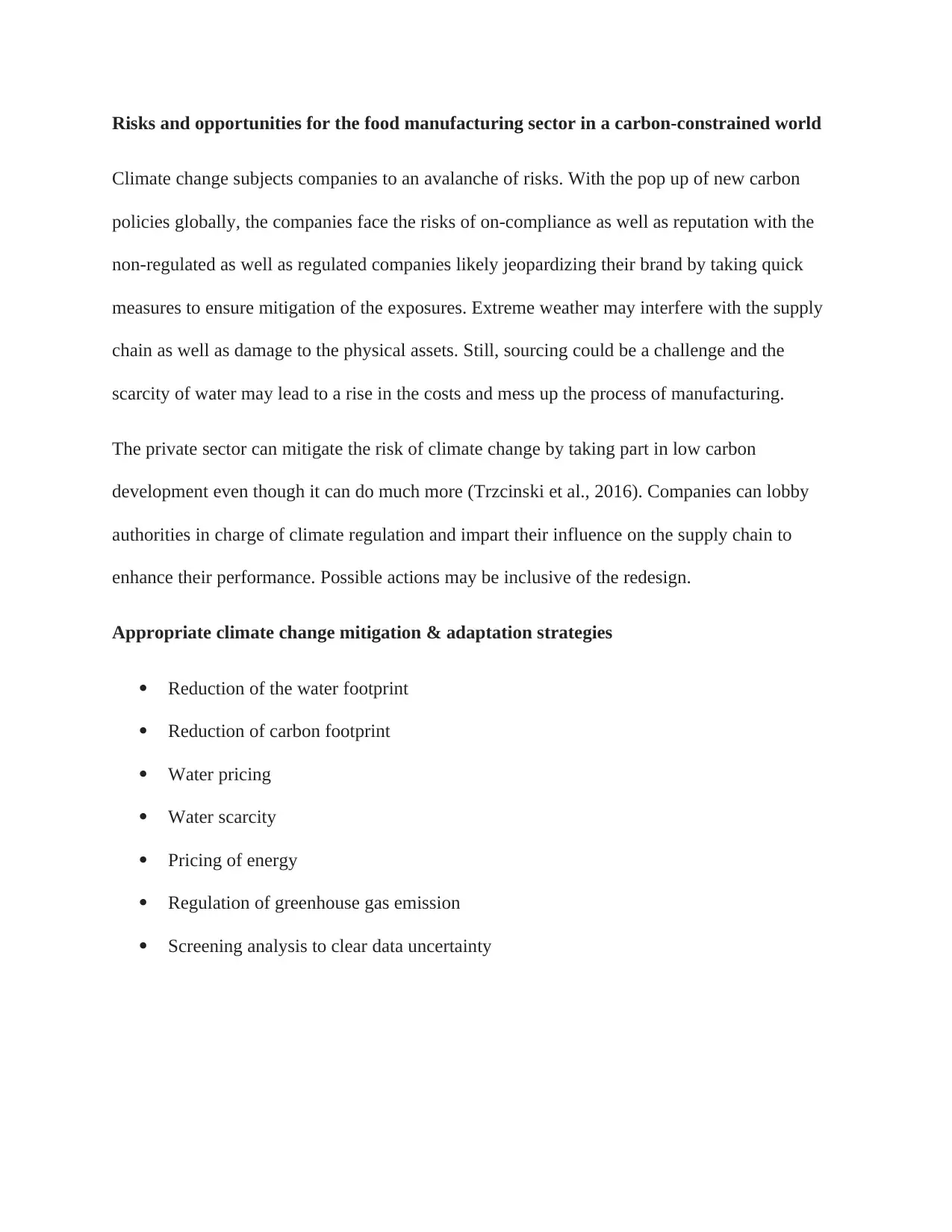
Risks and opportunities for the food manufacturing sector in a carbon-constrained world
Climate change subjects companies to an avalanche of risks. With the pop up of new carbon
policies globally, the companies face the risks of on-compliance as well as reputation with the
non-regulated as well as regulated companies likely jeopardizing their brand by taking quick
measures to ensure mitigation of the exposures. Extreme weather may interfere with the supply
chain as well as damage to the physical assets. Still, sourcing could be a challenge and the
scarcity of water may lead to a rise in the costs and mess up the process of manufacturing.
The private sector can mitigate the risk of climate change by taking part in low carbon
development even though it can do much more (Trzcinski et al., 2016). Companies can lobby
authorities in charge of climate regulation and impart their influence on the supply chain to
enhance their performance. Possible actions may be inclusive of the redesign.
Appropriate climate change mitigation & adaptation strategies
Reduction of the water footprint
Reduction of carbon footprint
Water pricing
Water scarcity
Pricing of energy
Regulation of greenhouse gas emission
Screening analysis to clear data uncertainty
Climate change subjects companies to an avalanche of risks. With the pop up of new carbon
policies globally, the companies face the risks of on-compliance as well as reputation with the
non-regulated as well as regulated companies likely jeopardizing their brand by taking quick
measures to ensure mitigation of the exposures. Extreme weather may interfere with the supply
chain as well as damage to the physical assets. Still, sourcing could be a challenge and the
scarcity of water may lead to a rise in the costs and mess up the process of manufacturing.
The private sector can mitigate the risk of climate change by taking part in low carbon
development even though it can do much more (Trzcinski et al., 2016). Companies can lobby
authorities in charge of climate regulation and impart their influence on the supply chain to
enhance their performance. Possible actions may be inclusive of the redesign.
Appropriate climate change mitigation & adaptation strategies
Reduction of the water footprint
Reduction of carbon footprint
Water pricing
Water scarcity
Pricing of energy
Regulation of greenhouse gas emission
Screening analysis to clear data uncertainty
Secure Best Marks with AI Grader
Need help grading? Try our AI Grader for instant feedback on your assignments.
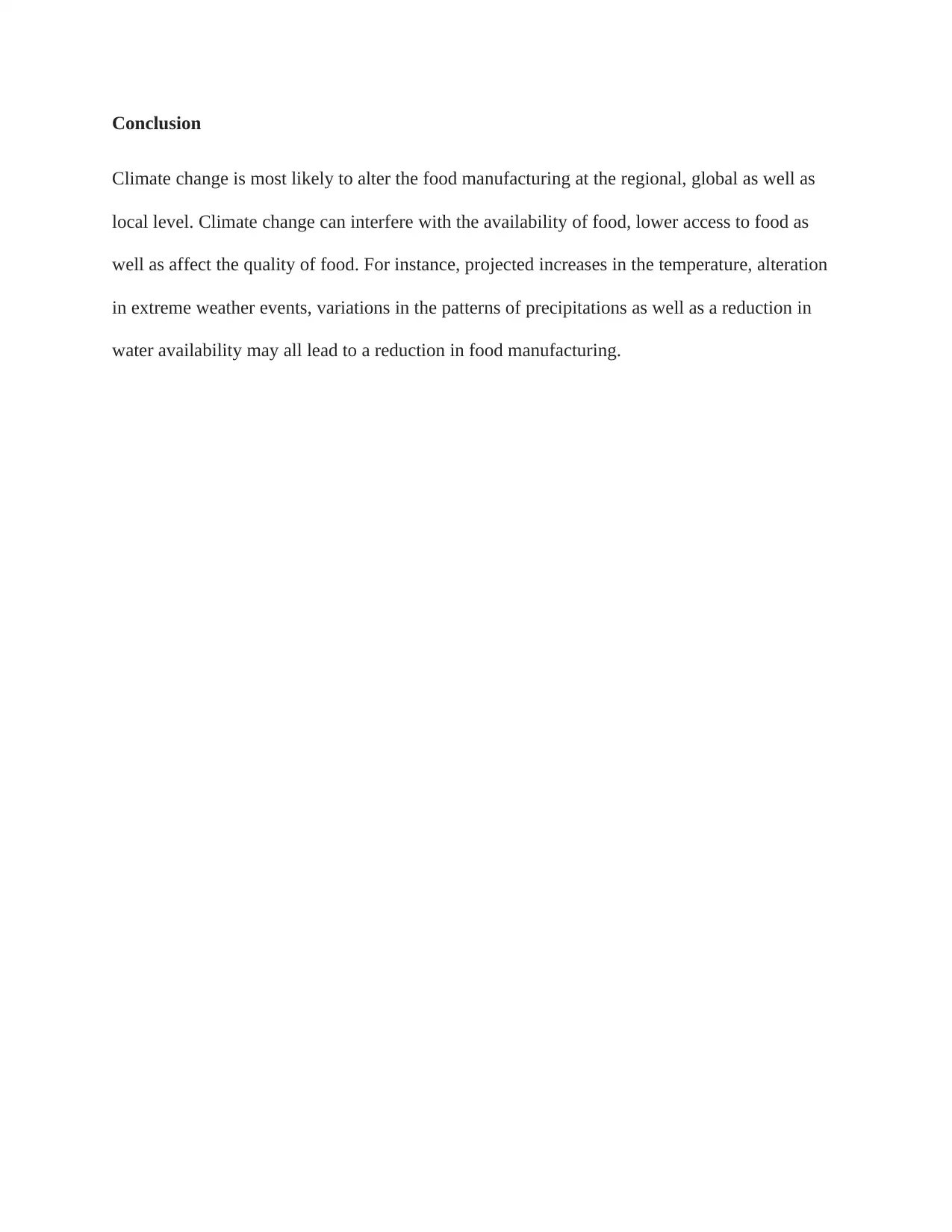
Conclusion
Climate change is most likely to alter the food manufacturing at the regional, global as well as
local level. Climate change can interfere with the availability of food, lower access to food as
well as affect the quality of food. For instance, projected increases in the temperature, alteration
in extreme weather events, variations in the patterns of precipitations as well as a reduction in
water availability may all lead to a reduction in food manufacturing.
Climate change is most likely to alter the food manufacturing at the regional, global as well as
local level. Climate change can interfere with the availability of food, lower access to food as
well as affect the quality of food. For instance, projected increases in the temperature, alteration
in extreme weather events, variations in the patterns of precipitations as well as a reduction in
water availability may all lead to a reduction in food manufacturing.

References
Deutsch, C.A., Tewksbury, J.J., Tigchelaar, M., Battisti, D.S., Merrill, S.C., Huey, R.B. and
Naylor, R.L., 2018. Increase in crop losses to insect pests in a warming
climate. Science, 361(6405), pp.916-919
Greaver, T.L., Clark, C.M., Compton, J.E., Vallano, D., Talhelm, A.F., Weaver, C.P., Band,
L.E., Baron, J.S., Davidson, E.A., Tague, C.L. and Felker-Quinn, E., 2016. Key ecological
responses to nitrogen are altered by climate change. Nature Climate Change, 6(9), p.836
https://blogs.ei.columbia.edu/2018/07/25/climate-change-food-agriculture
Hunter, E. and Röös, E., 2016. Fear of climate change consequences and predictors of intentions
to alter meat consumption. Food Policy, 62, pp.151-160
Jones, N.T., and Gilbert, B., 2016. Changing climate cues differentially alter zooplankton
dormancy dynamics across latitudes. Journal of Animal Ecology, 85(2), pp.559-569
Michalak, A.M., 2016. Study the role of climate change in extreme threats to water quality.
Nature News, 535(7612), p.349
Mundim, F.M., and Bruna, E.M., 2016. Is there a temperate bias in our understanding of how
climate change will alter plant-herbivore interactions? A meta-analysis of experimental
studies. The American Naturalist, 188(S1), pp.S74-S89
Myers, S.S., Smith, M.R., Guth, S., Golden, C.D., Vaitla, B., Mueller, N.D., Dangour, A.D. and
Huybers, P., 2017. Climate change and global food systems: potential impacts on food security
and undernutrition. Annual review of public health, 38, pp.259-277
Deutsch, C.A., Tewksbury, J.J., Tigchelaar, M., Battisti, D.S., Merrill, S.C., Huey, R.B. and
Naylor, R.L., 2018. Increase in crop losses to insect pests in a warming
climate. Science, 361(6405), pp.916-919
Greaver, T.L., Clark, C.M., Compton, J.E., Vallano, D., Talhelm, A.F., Weaver, C.P., Band,
L.E., Baron, J.S., Davidson, E.A., Tague, C.L. and Felker-Quinn, E., 2016. Key ecological
responses to nitrogen are altered by climate change. Nature Climate Change, 6(9), p.836
https://blogs.ei.columbia.edu/2018/07/25/climate-change-food-agriculture
Hunter, E. and Röös, E., 2016. Fear of climate change consequences and predictors of intentions
to alter meat consumption. Food Policy, 62, pp.151-160
Jones, N.T., and Gilbert, B., 2016. Changing climate cues differentially alter zooplankton
dormancy dynamics across latitudes. Journal of Animal Ecology, 85(2), pp.559-569
Michalak, A.M., 2016. Study the role of climate change in extreme threats to water quality.
Nature News, 535(7612), p.349
Mundim, F.M., and Bruna, E.M., 2016. Is there a temperate bias in our understanding of how
climate change will alter plant-herbivore interactions? A meta-analysis of experimental
studies. The American Naturalist, 188(S1), pp.S74-S89
Myers, S.S., Smith, M.R., Guth, S., Golden, C.D., Vaitla, B., Mueller, N.D., Dangour, A.D. and
Huybers, P., 2017. Climate change and global food systems: potential impacts on food security
and undernutrition. Annual review of public health, 38, pp.259-277

Rosenblatt, A.E. and Schmitz, O.J., 2016. Climate change, nutrition, and bottom-up and top-
down food web processes. Trends in ecology & evolution, 31(12), pp.965-975
Trzcinski, M.K., Srivastava, D.S., Corbara, B., Dézerald, O., Leroy, C., Carrias, J.F., Dejean, A.
and Cereghino, R., 2016. The effects of food web structure on ecosystem function exceed those
of precipitation. Journal of Animal Ecology, 85(5), pp.1147-1160
down food web processes. Trends in ecology & evolution, 31(12), pp.965-975
Trzcinski, M.K., Srivastava, D.S., Corbara, B., Dézerald, O., Leroy, C., Carrias, J.F., Dejean, A.
and Cereghino, R., 2016. The effects of food web structure on ecosystem function exceed those
of precipitation. Journal of Animal Ecology, 85(5), pp.1147-1160
1 out of 13
Related Documents
Your All-in-One AI-Powered Toolkit for Academic Success.
+13062052269
info@desklib.com
Available 24*7 on WhatsApp / Email
![[object Object]](/_next/static/media/star-bottom.7253800d.svg)
Unlock your academic potential
© 2024 | Zucol Services PVT LTD | All rights reserved.





